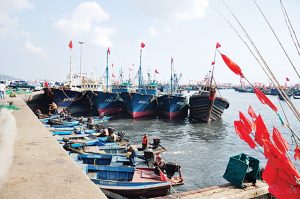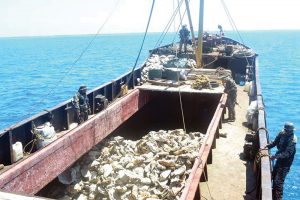Think I will stick to Lake Fishing .
 Of late South-east Asia’s seas have become areas that are fiercely contested by desperate fishermen with boats being blown up or even set on fire . This has all come about because of Asia’s rapidly growing appetite for fish with dwindling stocks of fish left in the ocean.
Of late South-east Asia’s seas have become areas that are fiercely contested by desperate fishermen with boats being blown up or even set on fire . This has all come about because of Asia’s rapidly growing appetite for fish with dwindling stocks of fish left in the ocean.
The increasing popularity of fish as a food source has been driven by rising incomes and a switch to healthier diets. This in turn has unfortunately led to an accelerated depletion of the region’s fish stocks, forcing fishermen to venture further afield to fish illegally in the waters of other countries.
There are also China’s aggressive territorial claims to the South China Sea. Chinese fishing vessels are encouraged to fish in the South China Sea and are protected by well-armed and equipped Chinese coast guards, triggering clashes at sea, including recent skirmishes with Indonesia.
According to a recent study by the British Columbia University in Canada, the South China Sea produces at least 10 million tonnes of fish equivalent to 12 percent of the global catch each year. However, in fact the true number is likely much higher when illegal and unregulated fishing is taken into account.
Globally, overfishing is depleting oceans, with 90 per cent of the world’s fisheries fully exploited or facing collapse, according to the United Nations’ Food and Agriculture Organisation. The depletion of fish stocks is of serious concern as seafood provides a major source of protein and income for millions of poor people in coastal areas. Shortages and increased competition also aggravate the problem in other ways. Unregulated trawling and illegal methods such as blast-fishing destroy breeding grounds, racking up even greater problems for the future. The top three fish-producing nations are all Asian – China, India and Vietnam.
Indonesia is the home of the world’s largest tuna fishing grounds, and produces more than 100,000 tonnes of tuna a year. The President of Indonesia, has greatly ramped up the country’s efforts to protect its fisheries and the livelihoods of millions of fishermen deemed to be under threat by illegal fishing. As it is estimated that the sector loses as much as US$25 billion annually to both local and foreign vessels that ply the Indonesian waters with no permits.
Blowing up foreign vessels sends a powerful message, says Maritime Affairs and Fisheries Minister Susi Pudjiastuti and the rejuvenation of fishing stocks will help Indonesia’s economy as other growth drivers falter, she told Bloomberg last year in Washington.
The Philippines has also been struggling to cope with plunging fish stocks, with 10 out of the 13 designated fishing grounds overfished. As a result, the population of small fish species, such as sardines and scad, are shrinking. The Philippines is also a major victim to poaching, with large numbers of Chinese vessels fishing in the Spratly archipelago. And it is not only the Chinese as in recent years, the Philippine Coast Guard has arrested fishermen from Vietnam and Taiwan illegally fishing in these waters. In fact to protect its depleting maritime resources, the Philippines is acquiring new patrol boats to help deal with the threat.
Tight lines everyone – Lets be careful out there
